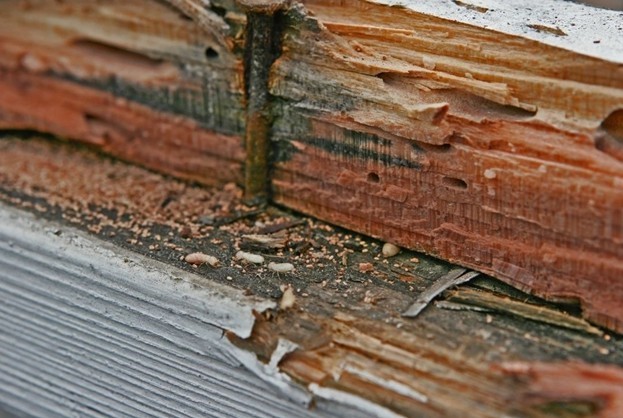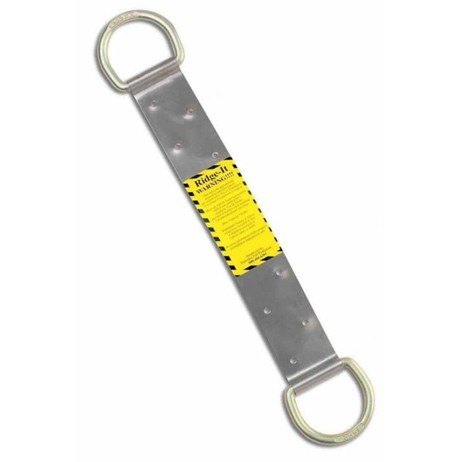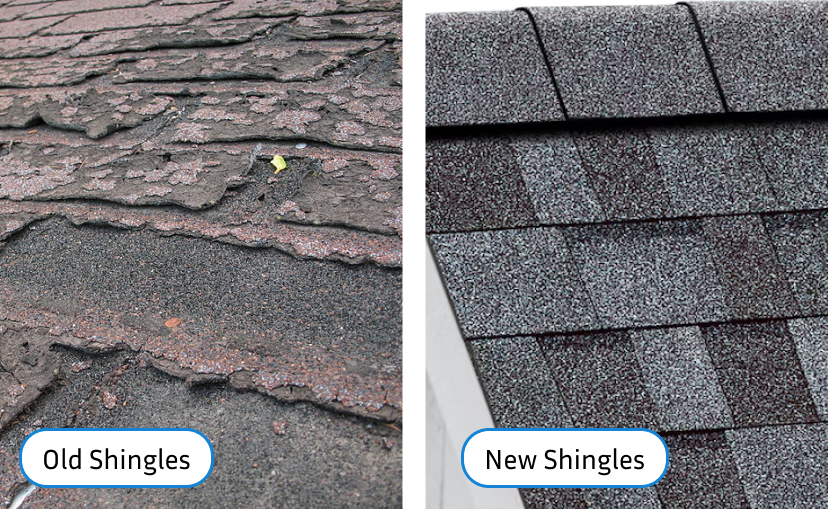Not sure if your siding just needs a repair or if it’s time to start fresh with a full replacement? You’re not alone. It’s one of the most common questions we hear from homeowners, especially after spotting warping, cracks, or moisture damage.
The answer depends on several key factors, including:
- the type of siding you have
- how widespread the damage is
- and how old your siding (and home) might be
When we inspect a home, we evaluate how your siding is performing overall and what makes the most sense for your property and your budget.
Here’s what we consider when helping you make the call.
First Question: What Material Is Your Siding?
Different materials wear down in different ways, and that plays a huge role in whether repairs are even possible. Materials also have different installation processes that make it difficult to repair small areas at a time.
Vinyl Siding
Vinyl is one of the most common siding materials and one of the trickiest to repair seamlessly. Since it’s installed with interlocking pieces, if a piece cracks, warps, or buckles, the entire panel usually has to be replaced.
Unfortunately, vinyl fades significantly over time, so even if we find a perfect match in style, it may not match in color unless your siding is relatively new. For homes with older or discontinued vinyl siding, repairs can stand out, which is why some homeowners choose to replace an entire wall or elevation for a cleaner look.
Metal Siding (Aluminum or Steel)
Metal siding is durable but vulnerable to dents, corrosion, and rust, especially if the finish has worn off. Like vinyl, spot repairs are tough, especially when the damage is cosmetic rather than structural.
Sections often need to be replaced, and matching the texture and color can be a challenge, particularly if your siding was installed decades ago. If the damage is minor and isolated, we may recommend a localized fix, but extensive denting or corrosion may call for full replacement.
Cedar or Wood Siding
Cedar siding is beautiful and can often be repaired in sections, especially when damage is caught early. We can usually replace individual boards or shingles if there’s minor rot, insect damage, or paint failure.
The biggest concern with wood is moisture. If water has gotten behind the siding or if the wood is soft, splintering, or moldy in multiple areas, it may not be worth patching. Widespread rot or a pest infestation often means it’s time for full replacement, especially if the siding hasn’t been maintained regularly with paint or sealant.

Fiber Cement Siding (like James Hardie)
Fiber cement is known for its strength and longevity so it’s more forgiving when it comes to repairs. Cracks, chips, and impact damage can often be addressed without replacing large sections.
If we find deeper damage, it may make more sense to replace a full elevation. We’ll look for moisture damage, soft spots in the substrate, or significant cracking across multiple boards. With fiber cement, we also check for signs of installation issues, which can compromise the siding’s performance even if it looks okay on the surface.
Question 2: What Is the Extent of the Damage?
One of the most important things we assess during a siding inspection is how large the damaged area is and how deep the problem goes. Surface issues like a few cracks or warped boards might not seem serious, but they can be signs of something much bigger happening underneath.
Cracks, warping, and loose boards often allow water to seep behind the siding, where it can quietly damage the sheathing or framing. Soft or spongy spots are another red flag because these usually indicate moisture has already made its way inside and is starting to break down the materials behind the exterior.
We also look for mold or mildew, which typically means water is trapped due to poor drainage or ventilation. In homes with cedar or other wood siding, signs of insect activity are a concern too, since pests like termites or carpenter ants thrive in moist, unprotected wood.
Visible rot or decay is one of the clearest signs that the siding is failing, and if it’s spread across multiple areas, repairs may only offer a temporary fix.
Sometimes, a small issue on the outside like a cracked panel turns out to be the tip of the iceberg. That’s why we take the time to thoroughly inspect not just the surface, but what’s going on underneath, so you can make the right call for your home.
Question 3: How Old Is Your Siding?
Even the most durable siding materials don’t last forever. If your siding is over 20 years old and especially if it hasn’t been consistently maintained, it could be nearing the end of its useful life.
During an inspection, we look beyond just individual trouble spots and evaluate the overall condition of the siding. Fading, shrinking, warping, cracking paint, and gaps in the seams are all signs that the material is beginning to fail.
The age of the home also plays a big role. Many older homes were built before today’s building codes required moisture barriers or proper ventilation behind the siding. We’ve seen homes without that protection have water intrusion over the years that quietly damages the framing, sheathing, and even insulation.
In these cases, replacing the siding isn’t just about updating the exterior, it’s an opportunity to correct outdated or missing structural protection and give your home a much stronger, longer-lasting envelope.
Sometimes homeowners are surprised to learn that their siding might still “look okay” but is no longer performing as it should. That’s why age, even without major visible damage, can be a key indicator that it’s time to consider replacement.
Question 4: What’s Your Budget?
We understand that a full siding replacement is a major investment, and it may not be something you’ve budgeted for. That’s why we always approach each project with flexibility and transparency.
If the damage is contained to one area and the rest of the siding is in good shape, we can recommend a targeted repair that extends the life of your current exterior while you plan for a future upgrade.
But when damage is widespread or repairs would be difficult or would result in mismatched siding, we’ll walk you through the pros and cons of moving forward with a replacement. We’re not here to pressure you, we’re here to help you understand your options and what each choice means for your home’s protection, appearance, and long-term value.
Some homeowners prefer to take a phased approach, replacing one side of the home at a time. Others are interested in financing options that help spread out the cost. Whatever your situation, we’ll help you find a solution that fits your timeline and your budget.
Question 5: How Much Do You Value Curb Appeal?
Even if a repair is technically possible, it’s not always the best choice visually. Older siding can be difficult to match due to fading, discontinued styles, or paint color changes. A patch may stand out, and not in a good way.
If you’re planning to sell your home soon, inconsistent or clearly patched siding can lower curb appeal and make buyers wonder about what other maintenance has been deferred. On the flip side, brand-new siding can instantly refresh your home’s appearance, increase its market value, and give buyers peace of mind knowing they won’t need to tackle exterior work right away.
Even if you’re not selling, your home’s exterior sets the tone for everything else. A full siding replacement can be one of the most dramatic ways to improve the look of your property—and enjoy the peace of mind that comes with a weather-tight, properly protected home.
Let’s Take a Look Together
Every home is different, and there’s no “one size fits all” when it comes to siding repairs or replacement. That’s why having a professional assessment is so important.
When we come out to your home, we’ll take the time to thoroughly inspect your siding, look at the underlying structure, and walk you through what we see—no pressure, no guesswork.
Whether you’re hoping for a small repair or ready to explore a full replacement, we’ll help you make the right call for your home, your budget, and your long-term peace of mind.
Subscribe to Pacific Exteriors LLC's Blog






Comments